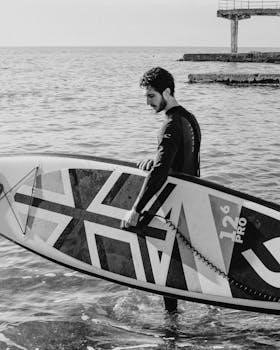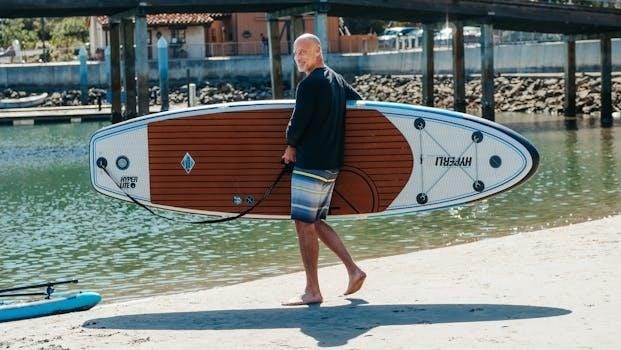Choosing the right size stand up paddle board (SUP) is crucial for enjoyment and performance. It’s a common question many beginners ask. SUPs vary significantly in size, shape, and volume. Understanding these differences is key to finding the perfect fit for you and your activities.
Importance of Correct SUP Size
Selecting the appropriate size SUP board is paramount for a safe and enjoyable experience on the water. A board that’s too small may lack stability, making it difficult to balance and maneuver, especially for beginners. This can lead to frustration and a higher likelihood of falling into the water. Conversely, a board that is too large can be cumbersome and challenging to paddle efficiently, reducing your speed and overall enjoyment. The correct size board, however, will provide the optimal balance of stability, maneuverability, and speed, allowing you to paddle comfortably and confidently. Furthermore, a board with the right buoyancy, volume and weight capacity enhances the longevity of the board and prevents any damage from exceeding the limits. It also ensures that the board performs as designed, whether you’re cruising on flat water, catching waves, or practicing yoga. A properly sized SUP will increase overall enjoyment, allowing you to focus on the beautiful scenery and the joy of paddling, rather than struggling to stay afloat. Ultimately, the right size board is a key component to a positive and rewarding paddle boarding experience.

Key Factors in Choosing SUP Size
Several key factors influence the ideal SUP size for you. These include paddler weight, height, experience level, and the intended use of the board. Considering each element ensures a suitable match for optimal performance and enjoyment.
Paddler’s Weight
Paddler weight is a primary factor when selecting a SUP board. The board’s volume and weight capacity must adequately support the paddler to maintain stability and proper buoyancy. A board that’s too small for a paddler’s weight will sit too low in the water, making it unstable and difficult to paddle. Conversely, a board with excessive volume for a lighter paddler can feel bulky and unresponsive. Most manufacturers provide recommended weight ranges for their boards, which should be carefully considered. For example, a board with a stated maximum weight capacity of 280 lbs would be a good fit for a paddler weighing 240 lbs.
When choosing, consider your maximum weight to ensure the board’s buoyancy is appropriate. For heavier paddlers, a larger board with greater volume is crucial to ensure the board sits correctly in the water. This will impact the boards performance and stability. This helps prevent the board from sinking or being difficult to maneuver. Boards designed for riders over 105 kilograms may have tailored dimensions to ensure balance and comfort.
Therefore, it is very important to pay attention to the recommended weight capacity to ensure that your paddleboarding experience is as safe and enjoyable as possible.
Paddler’s Height
While paddler’s weight is a crucial factor, height also plays a role in selecting the right SUP board. Height influences the appropriate paddle length and, to a lesser extent, the board’s overall size. A general rule of thumb is to add 9-10 inches to your height to determine the ideal paddle length. However, this can vary slightly depending on the type of paddle boarding you plan to do, such as recreational, touring, or surfing. For instance, some guides recommend adding 8-10 inches for recreational flatwater paddling.
Height can also influence the board size, though it’s less critical than weight. A taller person might benefit from a slightly longer board to accommodate their longer reach and potentially distribute their weight more evenly. However, the primary concern should still be the paddler’s weight in relation to the board’s volume and weight capacity.
Ultimately, it’s best to consider your height in conjunction with your weight and intended use to find a board that feels comfortable and performs well for you.
Experience Level
Your experience level significantly impacts the ideal SUP board size. Beginners typically benefit from wider, more stable boards that provide a forgiving platform to learn the basics. These boards, often around 10-11 feet long and 32-34 inches wide, offer increased stability, reducing the risk of falling. They are designed to be easy to paddle and balance on, making the learning process less daunting. A larger volume board is also suitable for beginners as it offers extra buoyancy and stability.
More experienced paddlers, on the other hand, might prefer narrower, longer boards that offer better glide and speed. They often have better balance and control, allowing them to handle less stable designs. Experienced paddlers might also choose a board based on a specific activity they enjoy, rather than just stability. This could include touring, surfing or racing. The ideal board size for an experienced paddler can differ based on activity.
It’s important to be honest about your current skill level to ensure you choose a board that matches your abilities, promoting a safe and enjoyable experience.
Intended Use/Activity
The intended use or activity plays a crucial role in determining the appropriate SUP board size. Different activities demand specific board characteristics to maximize performance and enjoyment. For instance, those interested in leisurely paddling or yoga will prioritize stability, requiring wider boards that offer a stable platform. A wider width provides more stability for various activities and reduces the risk of tipping over.
Touring and long-distance paddling necessitate longer, narrower boards to enhance glide and speed, allowing for efficient travel over longer distances. Surfing, however, requires shorter boards with greater maneuverability, enabling riders to catch waves easily. Boards with a planing hull are often preferred for surfing. Racing SUPs are designed for speed and require a specific shape and length to optimize performance. The paddle board size guide varies depending on your chosen activity.
Therefore, before selecting a SUP board, clearly define the primary activities you plan to engage in. This will help you choose the right board size and shape that is best suited for your needs.

Types of SUP Boards and Sizing
SUP boards come in various types, each designed for specific activities. These include all-around, touring, yoga, and surfing SUPs. Each type has unique size and shape considerations to optimize performance for its intended use.
All-Around SUPs
All-around SUPs are the most popular type, designed for versatility and suitable for various conditions. These boards typically range from 10 to 12 feet 6 inches in length and 32 to 34 inches in width, offering a good balance of stability and maneuverability for recreational paddling and light wave riding. They are a great choice for beginners and casual paddlers due to their stability and ease of use. These boards are designed to adapt well to cruising and wave-riding sessions in bayous and other inland waterways. They are often made with durable materials to withstand regular use and are a good option for the average SUP participant. Many of these boards feature planing hulls that make them stable and good for all-around use. Because of their versatility, they are a great starting point for many people when beginning their SUP journey.
They can also be used for SUP yoga, although dedicated yoga boards are wider for more stability. The length and width of these boards make them adaptable to various water types and activities. They strike a balance between being stable enough for beginners and responsive enough for more experienced paddlers. These boards are designed to be reliable and versatile, making them a popular choice for various water activities. They are the most common and a great option for those looking for a multi-purpose board.
Touring/Long-Distance SUPs
Touring or long-distance SUPs are designed for paddlers who want to cover greater distances and achieve better speed and glide. These boards are typically longer and narrower than all-around SUPs, usually ranging from 11 to 14 feet in length. The narrower width, often less than 32 inches, helps to reduce drag and increase efficiency in the water. This design allows for a smoother and faster paddling experience, making them ideal for exploring long stretches of coastline, lakes, or rivers. These boards are often displacement-hull SUPs which cut through the water more efficiently. The increased length provides better tracking and allows for more glide with each stroke, which is essential for long-distance paddling.
They are built for those who want to explore beyond short jaunts, making them perfect for adventurous paddlers. The design focuses on efficiency and speed to make long-distance paddling easier and more enjoyable. They are particularly suited for more experienced paddlers looking to maximize their speed and efficiency on the water. While less stable than all-around boards, they offer superior performance for long distance endeavors. The longer length helps maintain a straight line and reduces the need to constantly switch sides of your paddle.
Yoga SUPs
Yoga SUPs are specifically designed for practicing yoga on the water, and therefore stability is the most crucial factor when choosing one. These boards typically feature a wider design, often 34 inches or more, to provide a stable platform for various yoga poses. Lengths around 10 to 11 feet are generally considered ideal for this purpose, offering a good balance between stability and maneuverability. The deck of a yoga SUP is often covered with a soft, grippy material to enhance comfort and prevent slipping during poses. The increased width provides a secure base, allowing you to focus on your practice without worrying about tipping over.
The primary goal of a yoga SUP is to provide a stable and comfortable platform to perform yoga and fitness activities. These boards will have a flat, stable deck that is generally full length for greater accessibility. The extra width allows for a greater variety of poses while maintaining balance. They often are more buoyant than other types of boards. The more stable the board, the more enjoyable the experience. They are often not the fastest boards but are designed specifically for stability.
Surfing SUPs
Surfing SUPs are designed for catching waves and require different characteristics than other types of paddle boards. These boards are generally shorter, typically ranging from 8 to 10 feet, which enhances their maneuverability in the surf. A narrower width is also common, allowing for quicker turns and a more responsive feel on the wave. The overall design of a surfing SUP is focused on performance and agility. They are designed to be easier to handle on waves.
These boards are built to maximize maneuverability and responsiveness on waves. The shorter length and narrower width enable quick turns and better control when riding waves. These boards typically have a more pronounced rocker (the curve from nose to tail) which helps them to fit into the curve of a wave. Surfing SUPs are not ideal for flat water paddling or touring, as their design is specifically tailored for wave riding. They are often made with materials that make them more durable for the rigors of surfing. The fins are also designed to help them cut through the water while surfing.

SUP Board Dimensions
Understanding SUP board dimensions, like length, width, and volume is crucial. Length affects speed and glide, with longer boards being faster. Width impacts stability; wider boards are more stable. Volume influences weight capacity and buoyancy, and all these factors are key to performance.
Length, Width, and Volume
The length of a SUP board significantly impacts its performance. Shorter boards, typically around 8 to 10 feet, are more maneuverable and ideal for surfing. Medium-length boards, between 10 and 12 feet, are popular for all-around use, providing a good balance of stability and speed. Longer boards, often exceeding 12 feet, are designed for touring and long-distance paddling, offering better glide and efficiency. The width of a SUP board is another critical factor. Wider boards, usually 32 to 36 inches, offer greater stability, making them suitable for beginners and activities like yoga. Narrower boards, less than 32 inches, are faster but less stable, preferred by experienced paddlers and for racing. The volume of a SUP board, measured in liters, determines its buoyancy and weight capacity. A higher volume board can support more weight and provides greater stability; Matching the volume to your weight and intended use is crucial for optimal performance. Generally, beginners benefit from higher volume boards for enhanced stability. Understanding these dimensions – length, width, and volume – allows you to choose a board that best suits your needs, skill level, and the type of paddling you plan to do.

Weight Capacity
Weight capacity is a vital consideration when selecting a stand-up paddleboard. Each board is designed with a specific maximum weight limit that it can safely and effectively support. Exceeding this limit can compromise the board’s performance, stability, and even its structural integrity. A paddleboard’s weight capacity is determined by its volume, which is the amount of water it displaces. A higher volume board can support more weight. It’s essential to choose a board with a weight capacity that is greater than your own weight, and also accounts for any gear you plan to bring along. If you’re planning to paddle with additional weight, such as a child, a pet, or gear for fishing or touring, you must factor this into your calculations. A board that is overloaded will sit lower in the water, making it less stable and harder to paddle. Conversely, a board with a weight capacity that is significantly higher than your weight may be less maneuverable. It is therefore important to choose a board whose weight capacity aligns with your specific needs to ensure a safe and enjoyable experience on the water. Always check the manufacturer’s specifications for accurate weight capacity information.




Leave a Reply
You must be logged in to post a comment.